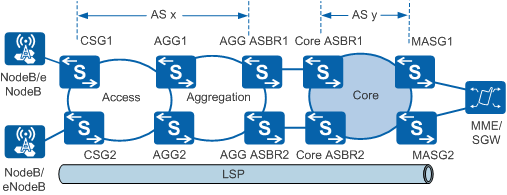Application of Seamless MPLS in VPN
Because MPLS technologies see widespread use, many service providers use MPLS-based L3VPN/L2VPN solutions to construct a multi-service bearer network. To allow service providers to quickly provision services over the bearer network and reduce their service deployment costs to improve market competitiveness, seamless MPLS establishes an end-to-end LSP across the access, aggregation, and core layers, implementing MPLS-based service forwarding on the entire network.
Figure 1 shows a long term evolution (LTE) network. The access, aggregation, and core layers of this network belong to two ASs. Different VPN instances are configured for different services on the CSG and MASG to connect them to NodeB (WCDMA 3G site)/eNodeB (LTE site) and Mobility Management Entity (MME)/Service Gateway (SGW) respectively.
To transmit VPN services on the network, the inter-AS seamless MPLS solution establishes an LSP between the CSG and MASG to implement interworking between NodeB/eNodeB and MME/SGW. If the low performance CSG cannot meet the network requirements, configuring HVPN between the CSG and AGG helps to reduce the load of the CSG. As a result, there is no need to replace the CSG with a higher performance device, lowering the networking cost.
